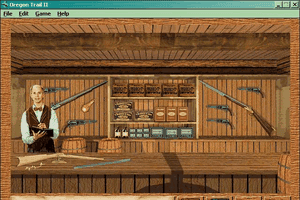
Your oxen were also subject to illness and death. People could also die from drowning or a broken leg. Throughout the course of the game, members of your party could fall ill and die from a variety of causes, such as measles, snakebite, dysentery, typhoid, cholera, and exhaustion. For example, hunting during winter would result in graphics showing grass covered in snow. Also in the later version, you could hunt in different environments. Some would consider this a realistic representation of the wild west. It was extremely common for players to kill several thousand pounds worth of animals, only to waste the large majority of it. In later versions, as long as there were at least two living members of the wagon party, 200 pounds could be carried back to the wagon.

While the amount of wild game shot during a hunting excursion is limited by only the player's supply of bullets, the maximum amount that can be carried back to the wagon is 100 pounds in early versions of the game. Deer (eastern section) and elk (western section) were in the middle in terms of speed, size, and food yield bear were between bison and deer in all three properties. Bison were the slowest moving targets and yielded the most food, while rabbits and squirrels were fast and offered very small amounts of food. In later versions, players hunted with a crosshair controlled by the mouse. Later, players would control a little man who was capable of pointing a rifle in eight directions and firing single shots at animals. A more advanced version of the hunting game had Deer and Rabbit run across the top of the screen with the player pressing the space bar to fire a cloud of shot from the bottom of the screen (presumably from the unseen hunter), timing being important to hit the animals. In the original version, there were no graphics and players were timed on how fast they could type "BANG," "WHAM," or "POW," with misspelled words resulting in a failed hunt. Using guns and bullets purchased over the course of the game, players select the hunt option and hunt wild animals to add to their food reserves.
#The oregon trail 5th edition emulator series
The program was then adapted by John Cook for the Apple II, and provided on A.P.P.L.E.'s PDS Disk series #108.

It was written in BASIC 3.1 for the CDC Cyber 70/73-26.

The first published version of The Oregon Trail was in Creative Computing's May-June 1978 issue. In 1978 MECC began encouraging its schools to adopt the Apple II microcomputer. The game became one of the network's most popular programs, with thousands of players monthly. He added many historically accurate features and uploaded The Oregon Trail into the organization's time-sharing network, where it could be accessed by schools across Minnesota.
#The oregon trail 5th edition emulator software
In 1974 Rawitsch took a job at Minnesota Educational Computing Consortium, or MECC, a state-funded organization that developed educational software for the classroom. When the next semester ended, however, Rawitsch deleted the program, although he printed out a copy of the source code. Despite bugs, the game was immediately popular, and he made it available to others on Minneapolis Public Schools' time-sharing service. The Oregon Trail debuted to Rawitsch's class on 3 December 1971. One of these students, senior Don Rawitsch, had the idea to create a computer program for a history class he was teaching, and recruited two of his friends, Paul Dillenberger and Bill Heinemann, both of whom were students teaching math, to help. The Oregon Trail was created in 1971 by three student teachers at Carleton College in Northfield, Minnesota, in the HP Time-Shared BASIC environment running on an HP-2100 minicomputer.


 0 kommentar(er)
0 kommentar(er)
